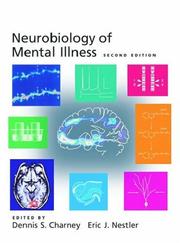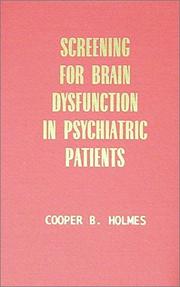| Listing 1 - 10 of 11 | << page >> |
Sort by
|

ISBN: 2729600728 9782729600723 Year: 1984 Publisher: Paris: InterÉditions,
Abstract | Keywords | Export | Availability | Bookmark
 Loading...
Loading...Choose an application
- Reference Manager
- EndNote
- RefWorks (Direct export to RefWorks)
Psychoanalysis --- Mind and body --- Mental illness --- Physiological aspects --- Mental illness - Physiological aspects

ISBN: 0195149629 9780195149623 Year: 2004 Publisher: Oxford: Oxford university press,
Abstract | Keywords | Export | Availability | Bookmark
 Loading...
Loading...Choose an application
- Reference Manager
- EndNote
- RefWorks (Direct export to RefWorks)
Neurobiology --- Mental Disorders --- Neuropsychiatry --- Mental illness --- Physiological aspects --- Mental illness - Physiological aspects

ISBN: 0398082669 9780398082666 0398069212 9780398069216 0398069077 9780398069070 Year: 1998 Publisher: Springfield : Charles C Thomas,
Abstract | Keywords | Export | Availability | Bookmark
 Loading...
Loading...Choose an application
- Reference Manager
- EndNote
- RefWorks (Direct export to RefWorks)
This book presents how medical diseases can be misdiagnosed as psychiatric disorders and how clinicians without extensive training in the neurosciences can do a competent job of screening psychiatric clients for possible brain disorders. In the author's work, he has seen over and over again how medical diseases can present with what appear to be classic psychological symptoms. The client is not only misdiagnosed but is then denied the medical treatment he or she needs. The research cited in this book, dating back to the 1890s, establishes beyond a doubt that such misdiagnoses are more common t

ISBN: 0880481862 Year: 1990 Publisher: Washington, DC American Psychiatric Press
Abstract | Keywords | Export | Availability | Bookmark
 Loading...
Loading...Choose an application
- Reference Manager
- EndNote
- RefWorks (Direct export to RefWorks)
Book
ISBN: 9780393071221 0393071227 Year: 2019 Publisher: New-York: W. W. Norton,
Abstract | Keywords | Export | Availability | Bookmark
 Loading...
Loading...Choose an application
- Reference Manager
- EndNote
- RefWorks (Direct export to RefWorks)
Mind Fixers tells the history of psychiatry’s quest to understand the biological basis of mental illness and asks where we need to go from here.In Mind Fixers, Anne Harrington, author of The Cure Within, explores psychiatry’s repeatedly frustrated struggle to understand mental disorder in biomedical terms. She shows how the stalling of early twentieth century efforts in this direction allowed Freudians and social scientists to insist, with some justification, that they had better ways of analyzing and fixing minds.But when the Freudians overreached, they drove psychiatry into a state of crisis that a new “biological revolution” was meant to alleviate. Harrington shows how little that biological revolution had to do with breakthroughs in science, and why the field has fallen into a state of crisis in our own time.Mind Fixers makes clear that psychiatry’s waxing and waning biological enthusiasms have been shaped not just by developments in the clinic and lab, but also by a surprising range of social factors, including immigration, warfare, grassroots activism, and assumptions about race and gender. Government programs designed to empty the state mental hospitals, acrid rivalries between different factions in the field, industry profit mongering, consumerism, and an uncritical media have all contributed to the story as well.In focusing particularly on the search for the biological roots of schizophrenia, depression, and bipolar disorder, Harrington underscores the high human stakes for the millions of people who have sought medical answers for their mental suffering. This is not just a story about doctors and scientists, but about countless ordinary people and their loved ones. A clear-eyed, evenhanded, and yet passionate tour de force, Mind Fixers recounts the past and present struggle to make mental illness a biological problem in order to lay the groundwork for creating a better future, both for those who suffer and for those whose job it is to care for them.

ISBN: 0306436213 Year: 1991 Publisher: New York London Plenum Medical Book Company
Abstract | Keywords | Export | Availability | Bookmark
 Loading...
Loading...Choose an application
- Reference Manager
- EndNote
- RefWorks (Direct export to RefWorks)

ISBN: 0897666488 Year: 1992 Volume: 658 Publisher: New York (N.Y.) : New York academy of sciences,
Abstract | Keywords | Export | Availability | Bookmark
 Loading...
Loading...Choose an application
- Reference Manager
- EndNote
- RefWorks (Direct export to RefWorks)
Brain --- Evoked potentials (Electrophysiology) --- Mental illness --- Psychophysiology --- Schizophrenia --- Mental Disorders --- Psychology, Experimental --- Psychopathology --- Congresses. --- Physiological aspects --- physiopathology --- congresses. --- Congresses --- Psychologie physiologique --- Mental illness - Physiological aspects - Congresses. --- Evoked potentials (Electrophysiology) - Congresses. --- Psychophysiology - Congresses. --- Schizophrenia - Physiological aspects - Congresses. --- Brain - Psychophysiology - Congresses.

ISBN: 0824768353 0824768922 0824769651 082476966X 0824769678 0824769686 9780824768928 Year: 1980 Volume: 2 1 Publisher: New York (N.Y.): Dekker,
Abstract | Keywords | Export | Availability | Bookmark
 Loading...
Loading...Choose an application
- Reference Manager
- EndNote
- RefWorks (Direct export to RefWorks)
Animal psychology and neurophysiology --- Psychiatry --- Psychophysiology --- Mental disorders --- Psychotropic drugs --- Psychopharmacology --- Endocrinology --- Neurochemistry --- Biological psychiatry --- Psychiatrie biologique --- Handbooks. --- Mental Disorders --- Psychotropic Drugs --- Mental illness --- Physiological aspects --- Behavioral physiology --- Physiological psychology --- Physiopsychology --- Psychology, Physiological --- Somatopsychics --- Physiology --- Psychobiology --- Mind and body --- Psychiatrists --- Psychiatrist --- Psychiatry, Physiological --- Psychological manifestations of general diseases --- Mental illness - Physiological aspects
Book
ISBN: 0199349037 0199934967 9780199934966 0199798265 9780199798261 0199857547 9780199857548 0199398461 9780199398461 9781283098335 1283098334 9780199934959 0199934959 0195325338 9780195325331 0190240814 Year: 2013 Publisher: New York : Oxford University Press,
Abstract | Keywords | Export | Availability | Bookmark
 Loading...
Loading...Choose an application
- Reference Manager
- EndNote
- RefWorks (Direct export to RefWorks)
Our understanding of the neurobiological basis of psychiatric disease has accelerated in the past five years. The fourth edition of Neurobiology of Mental Illness has been completely revamped given these advances and discoveries on the neurobiologic foundations of psychiatry. Like its predecessors the book begins with an overview of the basic science. The emerging technologies in Section 2 have been extensively redone to match the progress in the field including new chapters on the applications of stem cells, optogenetics, and image guided stimulation to our understanding and treatment of psyc
Neuropsychiatry. --- Mental illness --- Psychiatry, Physiological --- Psychological manifestations of general diseases --- Psychophysiology --- Behavioral neurology --- Biological psychiatry --- Neurology --- Physiological aspects. --- Physiology of nerves and sense organs --- Psychiatry --- Mental disorders --- Mental Disorders --- Neurobiology. --- Etiology. --- Physiopathology. --- Therapy. --- Neuropsychiatry --- Mental illness - Physiological aspects --- Mental Disorders - etiology --- Mental Disorders - physiopathology --- Mental Disorders - therapy --- Neurobiology --- neurobiologie --- psychiatrie --- Physiological aspects
Book
ISBN: 8132208242 8132208250 Year: 2014 Publisher: New Delhi : Springer India : Imprint: Springer,
Abstract | Keywords | Export | Availability | Bookmark
 Loading...
Loading...Choose an application
- Reference Manager
- EndNote
- RefWorks (Direct export to RefWorks)
The book aims to cover basic physiologic functions of melatonin, and its therapeutic applications in humans for a variety of clinically relevant disorders. This book contains chapters on the recent aspects of melatonin physiology, its receptors and their role in mitochondrial function, its immunomodulatory role and importance in seasonal dependent diseases, role in human reproduction, role in sleep, circadian rhythm and sleep disorders, role in neurologic disorders such as Parkinson’s disease, Alzheimer’s disease. Additionally, melatonin’s therapeutic use in neurobehavioral disorders in children, migraine and tension headache is also covered in this book. Melatonin’s antioxidant role in Duchenne’s muscular dystrophy and in glaucoma have also been discussed in short chapters. Two major melatonin agonists, ramelteon and agomelatine are discussed extensively on their current clinical application and ongoing research. Two chapters on agomelatonin and its role in mood disorders, particularly depressive disorders, are an important feature of this book. The chapters are written by experts from the global academia recognized for their original research and published work in the field of melatonin science.
Melatonin -- Diagnostic use. --- Melatonin -- Physiological effect. --- Melatonin. --- Mental illness -- Physiological aspects. --- Melatonin --- Tryptamines --- Hormones --- Biological Science Disciplines --- Natural Science Disciplines --- Indoles --- Hormones, Hormone Substitutes, and Hormone Antagonists --- Disciplines and Occupations --- Chemicals and Drugs --- Heterocyclic Compounds, 2-Ring --- Heterocyclic Compounds --- Pharmacology --- Medicine --- Human Anatomy & Physiology --- Health & Biological Sciences --- Internal Medicine --- Animal Biochemistry --- Physiological effect --- Physiological aspects. --- Therapeutic use. --- Acetylmethoxytryptamine --- Methoxyindolylethylacetamide --- Medicine. --- Internal medicine. --- Endocrinology. --- Oncology. --- Neurology. --- Psychiatry. --- Psychopharmacology. --- Medicine & Public Health. --- Internal Medicine. --- Pineal gland --- Tryptamine --- Secretions --- Oncology . --- Nervous system --- Neuropsychiatry --- Behavioral pharmacology --- Drugs --- Chemotherapy --- Psychotropic drugs --- Medicine and psychology --- Mental health --- Psychology, Pathological --- Internal medicine --- Medicine, Internal --- Tumors --- Diseases --- Psychotropic effects --- Endocrinology . --- Neurology .
| Listing 1 - 10 of 11 | << page >> |
Sort by
|

 Search
Search Feedback
Feedback About UniCat
About UniCat  Help
Help News
News